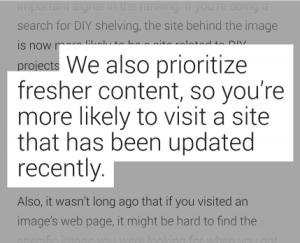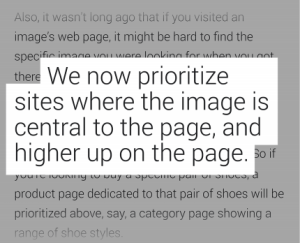We have put together some SEO tips to help you to boost your Google rankings and reap the benefits that brings. They are in line with top 2020 SEO practices, but they don’t just stop there. They’re a look to the future, given the consistent importance they have received so far. Implementation of these tips will require some work. But done right, with strategy and other SEO techniques in place, you can make some real progress with your current rankings. Enjoy!
Focus on User Experience
Generating traffic to your site is the first hurdle to overcome. But if your Click through Rate, Time on Page and Dwell Times are low, then it points towards a poor user experience.
Google uses a system called RankBrain to decide where pages should rank in search engine result pages (SERP). This means that results are ranked based on how users interact with search results.
Logically so, your website will start to lose ranking if users click on your site in the SERPs and immediately bounce off. This shows that your results are misaligned with the page content and therefore, are no use to users.
If there is a solid user experience, with them spending time on site, the website will start to gain traction and either move up the rankings or maintain the higher, current rankings.
Contents
ToggleHow to Do This
Focus on Medium Tail Keywords. What are those? We hear you ask. These are key terms that consist of two to three words. An example of this would be ‘nail salons Lincoln.’
The benefit of Medium Tail keywords is that they are more in-depth than Short Tail keywords, and therefore more competitive. They also have more search volume than Long Tail keywords.
Create High Quality Content
There is no doubt that producing high quality content is the backbone of SEO, and probably always will be. Think about it. The entire point of SEO is to generate traffic to your website. If the content on the site is poor, all your hard work has been done for nothing.
Anna Crowe, of Search Engine Journal, said: “Content affects everything in SEO. From your site structure and internal linking strategy to the types of links you build.”
A test we must measure our content by is asking ‘How relevant is my content?’ If your website is full of quality content that has nothing relevant to say, then users will leave pretty quickly. The old adage of quality over quantity really speaks volumes here.
How to Do This
If content writing isn’t your forte, make a start before even picking up a pen. Strategy is key to a consistent content marketing approach. Make sure you know your audience, identify your internal goals and plan the process.
Consider content that covers a wide range of styles. You’ve got tutorials, industry news and insights, expert advice, how-to guides, case studies, interviews, vlogs… the list is endless. Guest blogging is ideal as it raises awareness and builds trust, with someone else doing the writing.
Get the Ultimate Beginner’s Guide to Content Marketing here
Get Backlinks
For any website looking to boost their domain and page authority, backlinks are the way forward. Simply put, backlinks are links between your site and another relevant and authoritative website. This is key to remember. Make sure the sites you’re linking with are quality. Else it’ll actually have a detrimental effect on domain/page authority!
Consider backlinks like virtual networking. By growing your network, you’re encouraging relationships between you/your followers and other brands/their followers. It builds trust, and search engines recognise that and reward you for it in the shape of ranking position or search visibility.
Backlinks are a whole different ball game and we have just touched on it lightly. Check out Moz’s beginner guide to backlinking as a good starting point.
How to Do This
Competitive backlink research is essential when starting the backlink journey.
1 – Identify a competitor that is ranking well for your target keywords
2 – Use backlink tools like Moz Link Explorer to discover their backlink profile e.g. the collection of pages and domains linking to a website
3 – Use this data to target domains for your own link building campaign
Mobile SEO
It’s been a hot topic for a while now, and one SEOs and marketers keep going on about. But, for good reason. Making your website mobile-responsive is essential for today’s online demographic. A huge 63% of users access the internet using mobile phones. Can your business afford to lose out on that group of potential customers?
If your website is not mobile-friendly, there’s a real danger that Google may eliminate your site from SERPs in a mobile search.
How to Do This
Interestingly, there is an argument that websites should be built for mobile first, desktop second. This way, the sites wont have to be optimised for speed post-launch. Slow loading pages put off half of users from a webpage. Reversely, a load speed of 5 seconds or less guarantees 70% longer viewing sessions.
The Rise of the Visual Search
More people are conducting visual searches than ever before. Google Lens has already been used 1 billion times, as it helps users navigate day-to-day life. Visual searches are extremely handy for:
• Shopping
• Directions
• Local business reviews
• Translations
• Recipes
• Nutrition Information
• Identifying landmarks
• Much more
How to Do This
The basics in showing up on a visual search result is making sure your image SEO is on point. You should be doing this anyway! Use descriptive files names and write alt text for each image.
Google want to feature Google Image results from pages that are authoritative:

They also want to see fresh content:

And content that prioritises images:

Overhaul your ‘Almost’ Pages
Naturally, you want to maximise your top pages as much as possible. They are your shining examples of your website and showing them off makes sense. But what about the second-generation pages that, with a bit of nurturing, will hopefully become the new top pages on the block? SEO is all about looking to the future. By doing an overhaul, the overall outcome will be content that is fresh (big Google points) and should start to improve in rank. It’s a win, win situation!
How to Do This
Use Google Analytics and Search Console to identify the phrases on page two. These phrases need to have an average position that is greater than 10. These are the articles to overhaul.
Go through the following features with a fine-toothed comb:
• Content – Is it engaging? Is there a hook in the intro paragraph? Does it fulfil the promise made in the title? Do people care?
• Images – As in our previous tip, make sure all images are optimised. Try to make them pride of place within the article, and use them to support the content
• Meta Data – Does your meta description entice users? Are you really selling the content as well as you could?
What you can add in:
• FAQs – These are great for getting your content into ‘People Also Ask’ section on SERPs
• Statistics – The facts don’t lie
• Contributor quotes and input – Hello backlinks
To Conclude
SEO is an ever-evolving enigma that can be hard to get right. We have covered just some of the points that you can utilise to improve your Google rankings.
Using these tips, and constantly addressing your SEO will put you in good stead. Get in touch to work with us on your SEO strategy today





